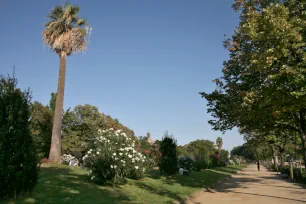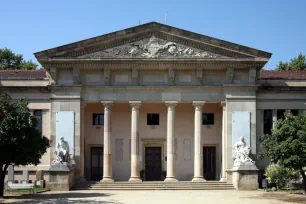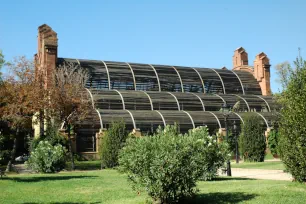The Parc de la Ciutadella is Barcelona’s most centrally located park. The park includes a zoo, a lake, a large fountain and several museums. The Catalan Parliament is seated in a building at the center of the park.


The thirty hectare (74 acre) large park forms a green oasis close to the always crowded historic center of Barcelona. The park is laid out nicely with wide promenades, colorful flowerbeds and many palm trees.
There’s much to see here: fountains and sculptures decorate the park, while several interesting buildings will catch the eye of architecture buffs.
There’s plenty to do as well; the park’s small lake is a popular spot where you can hire a rowing boat, there are several museums in the park and the zoo is always a popular attraction.
History
The Citadel
In 1714, after a thirteen-month-long siege, Barcelona fell to the army of king Philips V during the war of the Spanish Succession. In order to keep firm control over Barcelona, the Bourbon king built the largest fortress in Europe, a star-shaped citadel or ‘Ciutadella’. A large part of the Ribera district was demolished to make way for this fortress. The neighborhood was rebuilt thirty years later at another location as ‘Barceloneta’.



Ciutadella Demolishment
The much-hated symbol of central government was demolished between 1869 and 1878 after the Catalan general Prim handed over the citadel over to the city. Only three buildings survived: the chapel, the Governor’s palace and the arsenal, now home to the Catalan Parliament.
A New Park
Already in 1872 work to convert the area into a central urban park had started, but it progressed slowly. In 1885 the terrain was designated as the site of the 1888 Universal Exhibition, giving a boost to the development of the park. Many buildings were constructed, several of which have survived. The ‘Castel dels Tres Dragons’ is the most notable of these. It was built to resemble a medieval castle and served as a restaurant during the 1888 exhibition.
Sights & Attractions
Parc Zoologic


The most popular attraction in the Parc de la Ciutadella is no doubt the Parc Zoologic. About 7,500 animals representing four hundred different species can be found in this zoo, which occupies about thirteen hectares of the park. Some of the zoo’s most famous animals include gorillas, orangutans, dolphins, cheetahs, wolves, snow leopards, crocodiles and alligators. The zoo’s former star attraction, an albino gorilla known as Snow Flake, died in 2004.
The Cascada
At the northern corner of the park is the Cascada, a triumphal arch with waterfall and fountain built for the 1888 Universal exhibition. The Baroque construction was designed by Josep Fontsère – who was responsible for the conversion of the citadel site into a park – and took six years to complete. The design was loosely based on the famous Trevi Fountain in Rome. The architect was assisted by Antoni Gaudí, at the time still an apprentice.

Museums
The Natural History Museum of Barcelona, which manages the New Botanical Garden and the Museu Blau at the Forum building, also displays collections at the Parc de la Ciutadella, in the Martorell Museum and the Laboratory of Nature.
The museums are housed in some of the park’s most eye-catching structures. The Laboratory of Nature, which displays the geology and zoology collections of the Natural History Museum, is housed in the Castel dels Tres Dragons, a brick structure that was built by the Catalan architect Lluís Domènech i Montaner in the Modernistá style, an architectural style that would later become world-famous thanks to Antoni Gaudí.


The Martorell Museum takes an interesting angle at natural history by telling the history of natural history itself. It is housed in a neoclassical building, quite unusual for Barcelona. The building was created by Antoni Rovira i Trias as the city’s first public museum. It was long home to the Geology Museum.
More buildings
Between the two museum buildings stands the hivernacle, a conservatory that consists of two greenhouses that are connected by a large glass roof. A similar and even more interesting building is the Umbracle, a palm house which stands just south of the Martorell Museum. It has a vaulted wood-slat roof that allows rays of light inside the structure. The oldest building in the park is the Catalan Parliament Building, once part of the original Citadel. The parliament building is however not accessible to the public.
Statues

There are several statues in the park, the one that stand out most is a large stone mammoth. Kids love to climb on its trunk. There is also a modern sculpture created by Antoni Clavé, entitled ‘Monument to the World Fair’. A more conventional statue commemorates General Prim, who made the demolition of the citadel possible.

